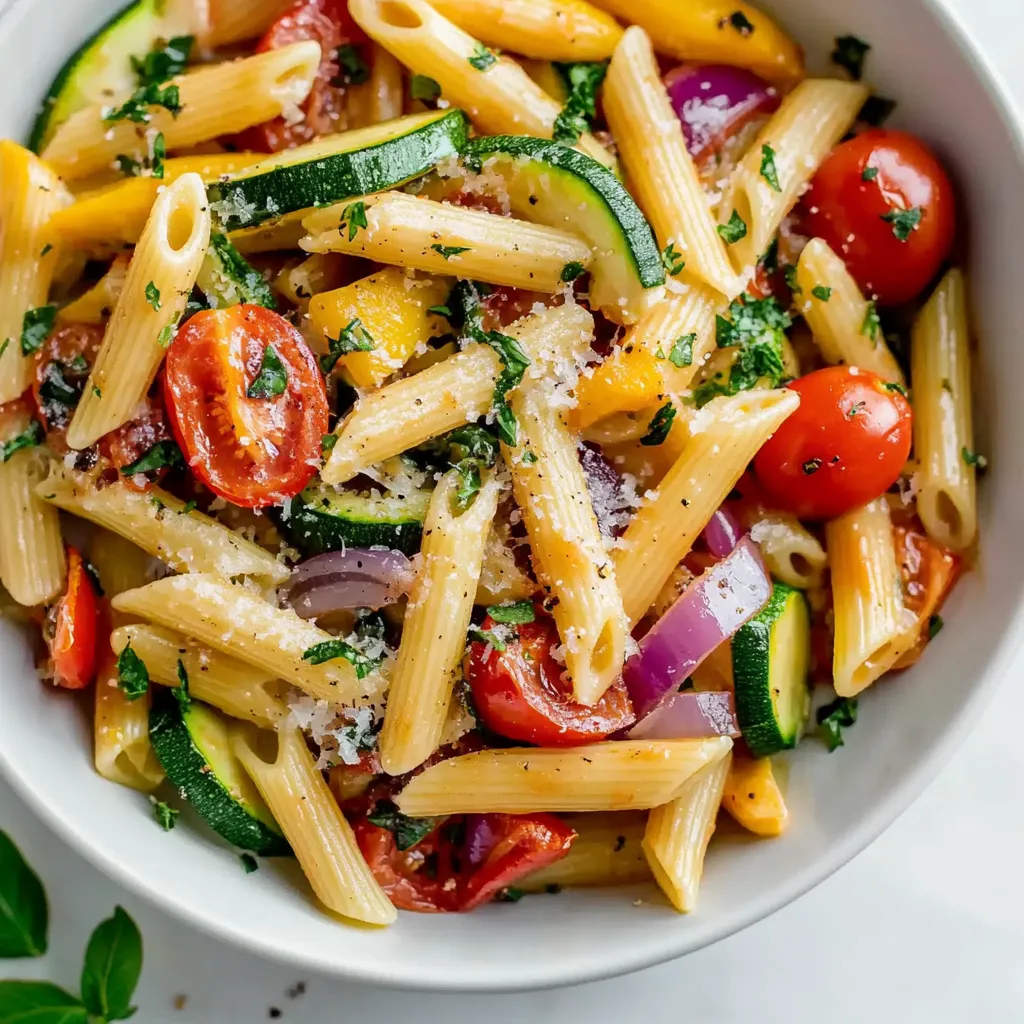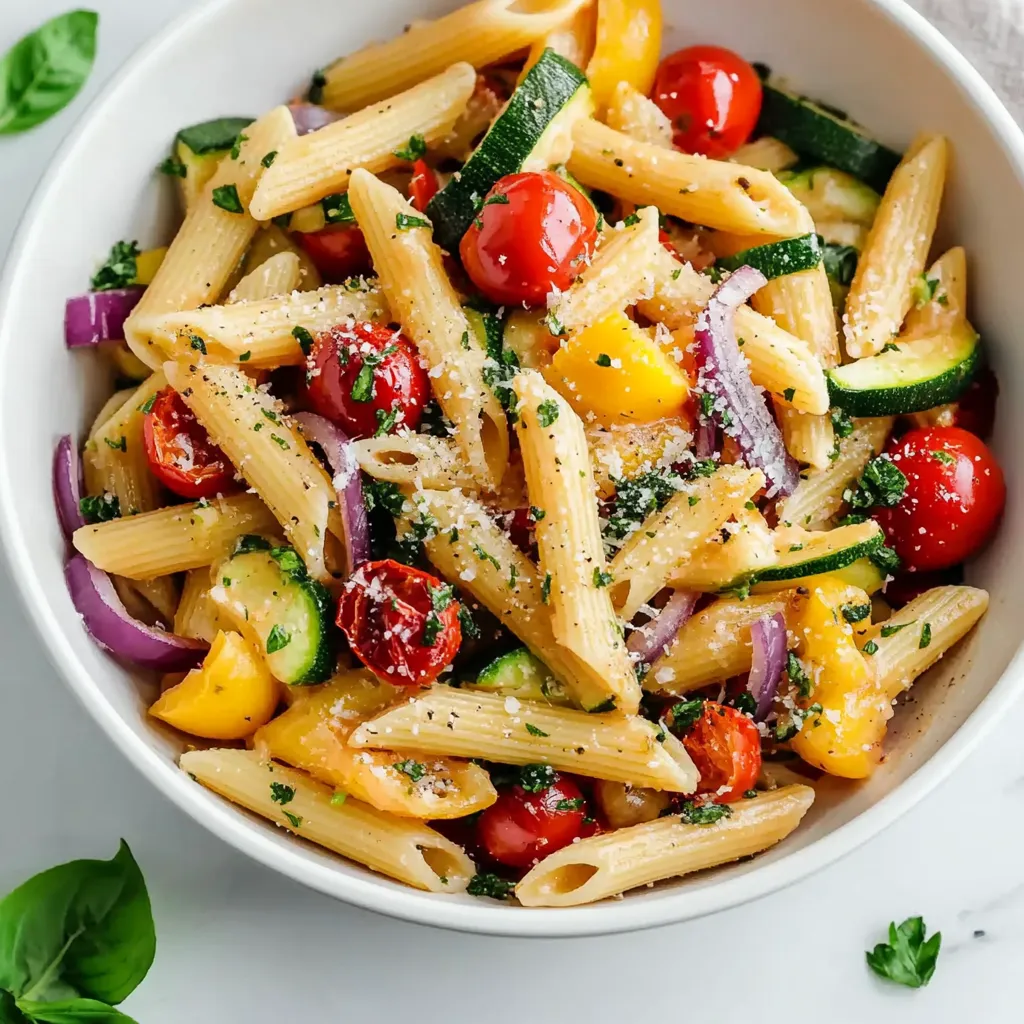 Bookmark
Bookmark
This vibrant pasta primavera celebrates the best of spring vegetables roasted to sweet perfection and tossed with al dente pasta. I created this recipe during a weekend farmers market adventure when I found myself with a bounty of colorful produce that was too beautiful to resist.
I first made this pasta for my sister when she visited during a particularly hectic work week. The simplicity and flavor impressed her so much that she now makes it weekly for her own family, calling it her "back pocket recipe" for dinner emergencies.
Ingredients
- Cherry tomatoes bursting with natural sweetness and creating a light sauce when roasted
- Zucchini adds tender texture and mild flavor that absorbs other ingredients beautifully
- Yellow bell pepper provides sweet crunch and vibrant color contrast
- Red onion becomes jammy and caramelized when roasted properly
- Olive oil use good quality for best flavor as it forms base of the sauce
- Dried basil infuses aromatics throughout while roasting
- Dried oregano adds classic Italian flavor that complements the vegetables
- Penne pasta ridges and hollow center capture sauce perfectly
- Fresh garlic adds punchy flavor foundation
- Balsamic vinegar provides tangy depth and helps deglaze all the roasted bits
- Fresh basil leaves brighten the final dish with color and fresh aroma
Step-by-Step Instructions
- Preheat and Prepare
- Set oven to 400°F and line your baking sheet with parchment paper. This temperature is perfect for caramelizing vegetables without burning them. The parchment prevents sticking and makes cleanup infinitely easier.
- Season Vegetables
- Toss cherry tomatoes, zucchini, bell pepper and red onion with olive oil and dried herbs until every piece is glistening. Make sure to distribute the seasonings evenly for consistent flavor throughout. This step builds the foundation of flavor.
- Roast to Perfection
- Arrange vegetables in a single layer with space between pieces. Overcrowding causes steaming instead of roasting. Watch for caramelized edges and slight wrinkling of tomatoes after about 20 minutes. The kitchen should fill with an incredible aroma.
- Cook Pasta
- Boil pasta in heavily salted water until just al dente. Test it about one minute before package directions suggest. Remember to reserve some starchy pasta water before draining. This liquid helps create a silky sauce that clings to every bite.
- Create Aromatic Base
- Gently sauté fresh garlic in a small amount of olive oil just until fragrant. Be vigilant here as garlic burns quickly and becomes bitter. The entire kitchen should fill with that wonderful garlic aroma within 30 seconds.
- Combine Components
- Add roasted vegetables to the skillet with all their flavorful juices. The balsamic vinegar goes in next, deglazing the pan and adding tanginess. Then add pasta and toss everything gently to avoid breaking the tender roasted vegetables.
- Adjust Consistency
- Add reserved pasta water a tablespoon at a time while stirring. The starchy water will emulsify with the olive oil and vegetable juices to create a light sauce that coats each piece of pasta perfectly. Stop when it reaches your desired consistency.
 Bookmark
Bookmark
My absolute favorite part of this dish is how the cherry tomatoes burst during roasting, creating little pockets of intense tomato flavor throughout the pasta. My husband always picks out the roasted red onions first, claiming they taste like candy when properly caramelized. This simple observation taught me that proper roasting can transform even the most humble ingredients.
Storing Leftovers
This pasta primavera keeps wonderfully in the refrigerator for up to three days in an airtight container. The flavors actually develop overnight, making it sometimes even better the next day. I often make a double batch specifically for planned leftovers. When reheating, add a splash of water or olive oil to refresh the sauce, and warm gently over medium heat rather than using the microwave which can make the pasta rubbery.
Seasonal Adaptations
The beauty of pasta primavera lies in its flexibility. In summer, substitute with sweet corn kernels, cherry tomatoes, and basil. Fall calls for butternut squash, sage, and perhaps some toasted walnuts. Winter versions shine with roasted brussels sprouts and cauliflower. The technique remains the same regardless of vegetable choice always roast until caramelized and tender. This adaptability makes this recipe a year round favorite that never grows tiresome.
Serving Suggestions
Serve this colorful pasta in shallow bowls to showcase the beautiful vegetables. A light sprinkle of freshly grated Parmesan adds wonderful savory depth, though the dish stands perfectly well on its own. For a complete meal, pair with a simple green salad dressed with lemon vinaigrette to provide refreshing contrast to the roasted flavors. A glass of crisp Pinot Grigio or Sauvignon Blanc complements the vegetable medley perfectly without overwhelming the delicate flavors.
Recipe FAQs
- → What's the best way to prevent the vegetables from getting soggy?
Avoid soggy vegetables by ensuring your oven is fully preheated to 400°F before roasting. Arrange vegetables in a single layer without overcrowding the pan (use two pans if needed). Pat vegetables dry before tossing with oil, and don't slice them too thin. The parchment paper helps create better airflow around the vegetables, promoting caramelization rather than steaming.
- → Can I prepare any components of this dish ahead of time?
The roasted vegetables can be prepared up to 2 days ahead and refrigerated in an airtight container. When ready to serve, bring them to room temperature while cooking the pasta, then warm the vegetables in the skillet with garlic before combining. For best results, cook the pasta fresh and add the balsamic vinegar only at the final assembly for the brightest flavor.
- → What can I substitute for balsamic vinegar?
If you don't have balsamic vinegar, you can substitute red wine vinegar mixed with a teaspoon of honey for similar sweet-tart notes. Lemon juice with a touch of maple syrup works well too. For a different flavor profile, try a splash of white wine reduced slightly in the pan, or even a few tablespoons of the pasta cooking water mixed with a teaspoon of Dijon mustard for creaminess.
- → How can I make this dish more substantial?
Transform this into a heartier meal by adding protein like grilled chicken, shrimp, or white beans. For a more indulgent version, stir in 1/4 cup of cream or mascarpone cheese when combining the pasta with vegetables. You can also add pine nuts or walnuts for crunch, or include extra vegetables like asparagus, broccoli, or mushrooms. A sprinkle of parmesan or crumbled feta cheese adds wonderful savory depth.
- → Why is reserving pasta water important?
Pasta water is culinary gold because it contains starch from the cooking pasta. When added to your finished dish, this starchy water helps create a silky sauce that clings perfectly to both pasta and vegetables. It provides moisture without diluting flavor and helps emulsify everything together. The salt in the water also enhances the overall seasoning. Always reserve some before draining, even if you don't end up using it all.
- → What's the best pasta shape for this dish?
Penne works beautifully because its tubular shape captures small pieces of vegetables and sauce, but other medium shapes like fusilli, farfalle, or rotini are excellent alternatives. Their twists and crevices hold the light sauce wonderfully. Shorter pastas generally work better than long strands for this dish, as they're easier to toss with the chunky vegetables and eat in balanced bites.
